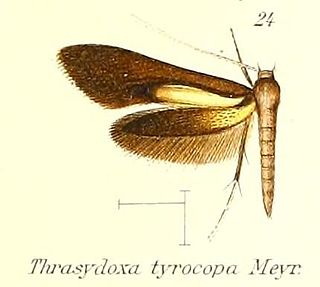
Cydia is a large genus of tortrix moths, belonging to the tribe Grapholitini of subfamily Olethreutinae. Its distinctness from and delimitation versus the tribe's type genus Grapholita requires further study.

Heliodinidae, commonly known as sun moths, is a family of small moths with slender bodies and narrow wings. Members of this family are found in most parts of the world. Heliodinid moths are brightly coloured day-flying moths. The base of the haustellum is bare. The scales on the head are compact and appear like a shield. Many Heliodinidae raise their hindlegs when resting but this is not a taxonomic feature and several genera like Epicroesa and Lamprolophus do not show this posture. Many Heliodinidae have the inner and outer spurs of the metatibia subequal. The larval host plants of the majority of species are in the Aizoaceae, Chenopodiaceae, Phytolaccaceae, Portulacaceae and Nyctaginaceae, all in the Order Caryophyllales. A few feed on Onagraceae, Araliaceae and Piperaceae. The pupae have long stiff hairs on their back sides.
Eucalyptra is a monotypic moth genus of the family Heliodinidae. Its only species, Eucalyptra picractis, is known from Java. Both the genus and the species were first described by Edward Meyrick in 1921.

Opogona is a genus of the fungus moth family, Tineidae. Therein, it belongs to the subfamily Hieroxestinae. As it includes Opogona omoscopa, the type species of the now-abolished genus Hieroxestis, it is the type genus of its subfamily.
Leguminivora is a genus of moths belonging to the subfamily Olethreutinae of the family Tortricidae.

Xestocasis is a moth genus of the superfamily Gelechioidea. It was described in the family Heliodinidae and is sometimes also listed in the Cosmopterigidae, but actually seems to belong in the Oecophoridae.

Xyloryctidae is a family of moths contained within the superfamily Gelechioidea described by Edward Meyrick in 1890. Most genera are found in the Indo-Australian region. While many of these moths are tiny, some members of the family grow to a wingspan of up to 66 mm, making them giants among the micromoths.
Cotaena is a genus of sedge moths originally described by Francis Walker in 1865.

Molybdurga is a genus of moths of the family Heliodinidae. There is only one species in this genus: Molybdurga metallophoraMeyrick, 1897 that is found in Australia.

Thrasydoxa is a genus of moths of the family Heliodinidae. There is only one species in this genus: Thrasydoxa tyrocopaMeyrick, 1912 that is found in Colombia.

Thriambeutis coryphaea is a species of moth of the family Heliodinidae.
Trichothyrsa taedifera is a moth of the family Heliodinidae first described by Edward Meyrick in 1912. It is found in Sri Lanka.
Trichothyrsa pyrrhocoma is a moth of the family Heliodinidae first described by Edward Meyrick in 1912. It is found in Sri Lanka.
Pyrozela xanthomima is a moth of the family Heliodinidae first described by Edward Meyrick in 1906. It is found in Sri Lanka.